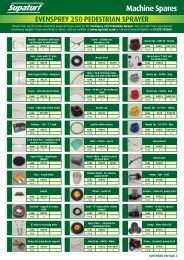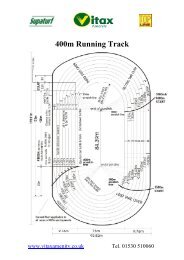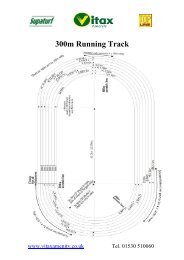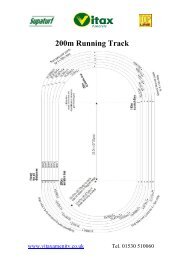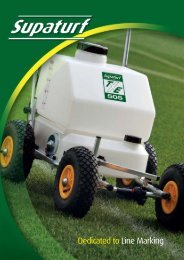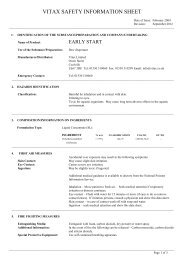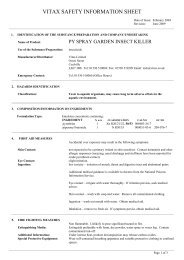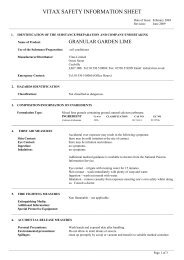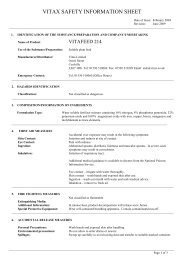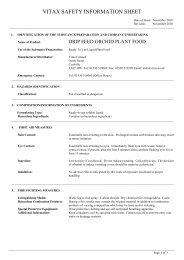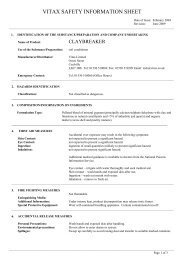New Estermone - Vitax
New Estermone - Vitax
New Estermone - Vitax
You also want an ePaper? Increase the reach of your titles
YUMPU automatically turns print PDFs into web optimized ePapers that Google loves.
VITAX SAFETY INFORMATION SHEET<br />
Date of Issue: February 2004<br />
Revision: June 2009<br />
__________________________________________________________________________________________________________<br />
1. IDENTIFICATION OF THE SUBSTANCE/PREPARATION AND COMPANY/UNDERTAKING<br />
Name of Product: NEW ESTERMONE<br />
Use of the Substance/Preparation: Selective weedkiller<br />
Manufacturer/Distributor: <strong>Vitax</strong> Limited<br />
Owen Street<br />
Coalville<br />
LE67 3DE Tel: 01530 510060 Fax: 01530 510299 Email: tech@vitax.co.uk<br />
Emergency Contact: Tel: 01530 510060 (Office Hours)<br />
________________________________________________________________________________________________________<br />
2. HAZARDS IDENTIFICATION<br />
Classification: May cause sensitisation by skin contact. Irritating to eyes. Toxic to aquatic<br />
organisms, may cause long-term adverse effects in the aquatic environment.<br />
Contains aromatic hydrocarbon solvent. May cause lung damage if swallowed.<br />
________________________________________________________________________________________________________<br />
3. COMPOSITION/INFORMATION ON INGREDIENTS<br />
Formulation Type: Emulsifiable concentrate containing:<br />
INGREDIENT % w/w CLASSIFICATION CAS NO EC NO<br />
2,4-D (ethyl hexyl ester) 19.8 Xn R22, 43, 50/53 001928-43-4 217-673-3<br />
Dicamba 3.5 Xn R22, 41, 52/53 001918-00-9 217-635-6<br />
Aromatic hydrocarbon distillate 56 Xn R65 064742-94-5 265-198-5<br />
091770-15-9<br />
________________________________________________________________________________________________________<br />
4. FIRST AID MEASURES<br />
Accidental over exposure may result in the following symptoms:<br />
Skin Contact: prolonged skin contact may give rise to degreasing and subsequent irritation. May<br />
cause sensitisation by skin contact.<br />
Eye Contact: irritation.<br />
Ingestion: may cause burning of oral mucosa, hypersalivation, stomach cramps, nausea and<br />
diarrhoea.<br />
Inhalation: high levels of solvent vapour may result in irritation to respiratory tract, headaches<br />
and nausea.<br />
Additional medical guidance is available to doctors from the National Poisons<br />
Information Service.<br />
Eye contact – irrigate with water thoroughly. If irritation persists, seek medical aid.<br />
Skin contact – wash with soap and water. Remove and wash contaminated clothing.<br />
Ingestion – wash out mouth with water and seek medical advice immediately. Do<br />
not induce vomiting.<br />
Inhalation – remove to fresh air. Seek medical aid if symptoms persist.<br />
________________________________________________________________________________________________________<br />
5. FIRE FIGHTING MEASURES<br />
Not classified as flammable.<br />
Extinguishing Media: Keep containers cool with water spray. Extinguish, preferably with foam, dry<br />
powder or water spray.<br />
Additional Information: In intense heat, product decomposition will release toxic fumes.<br />
__________________________________________________________________________________________________________<br />
Page 1 of 4
VITAX SAFETY INFORMATION SHEET<br />
Date of Issue: February 2004<br />
Revision: June 2009<br />
__________________________________________________________________________________________________________<br />
Special Protective Equipment: Wear self-contained breathing apparatus in confined spaces. Contain contaminated<br />
run-off.<br />
________________________________________________________________________________________________________<br />
6. ACCIDENTAL RELEASE MEASURES<br />
Personal Precautions: When dealing with spillage wear protective gloves, boots and overalls. Do not<br />
breathe vapour. Do not eat, drink or smoke. Wash hands and exposed skin after<br />
handling.<br />
Environmental precautions: Report to local water plc immediately if spillage enters drains and the Environment<br />
Agency or Scottish Environment Protective Agency if it enters surface or ground<br />
waters.<br />
Spillages: Soak up with absorbent material such as sand and transfer to suitable marked<br />
container, and keep safe before disposal.<br />
________________________________________________________________________________________________________<br />
7. HANDLING & STORAGE<br />
Handling: Do not block stack pallets.<br />
Storage: Store in original containers, tightly closed in a secure, well ventilated, cool but frostfree,<br />
dry area. Store clear of foodstuffs and in a separate stack from insecticides,<br />
fungicides and fertilisers. Make arrangements for containment of accidental spillage.<br />
_________________________________________________________________________________________________________<br />
8. EXPOSURE CONTROLS/ Occupational exposure standards (EH40) for 2,4-D in air: 10 mg/m 3 (8 hr) 20 mg/m 3<br />
PERSONAL PROTECTION (15 min). OEL recommended for solvent 5 mg/m 3 . Personal protective equipment<br />
recommended where engineering control of operator exposure is impractical:<br />
faceshield, chemical resistant gloves, rubber boots (when applying by hand-held<br />
equipment or clearing spillages) and coveralls.<br />
_______________________________________________________________________________________________________<br />
9. PHYSICAL & CHEMICAL Appearance oily liquid forming emulsion with water<br />
PROPERTIES Autoflammability > 400 deg C<br />
Odour strong aromatic<br />
Boiling point 200-265 deg C (for solvent)<br />
Explosion limits 0.6-6.0% (for solvent)<br />
Flash point > 70 deg C<br />
Flammability combustible<br />
Kinetic viscosity 3.863 x 10 -6 m 2 /s @ 40 deg C<br />
Melting point not determined<br />
Oxidising properties N/A<br />
pH (1%) 4<br />
Relative density 1.01 at 20 deg C<br />
Solubility miscible in water<br />
Surface tension 33.1 mN/m @ 25º deg C<br />
Vapour pressure not determined<br />
Other data none<br />
_____________________________________________________________________________________________________<br />
10. STABILITY & REACTIVITY<br />
Stability: stable under ambient conditions.<br />
Conditions to Avoid: avoid high temperatures - not classified as flammable but will burn if involved in a<br />
fire producing toxic fumes.<br />
Materials to Avoid:<br />
Hazardous Decomposition Products: not classified as flammable but will burn if involved in a fire producing toxic fumes.<br />
__________________________________________________________________________________________________________<br />
Page 2 of 4
VITAX SAFETY INFORMATION SHEET<br />
Date of Issue: February 2004<br />
Revision: June 2009<br />
__________________________________________________________________________________________________________<br />
11. TOXICOLOGICAL LD50 acute oral rat > 2000 mg/kg (by calculation)<br />
INFORMATION Suspected eye irritant.<br />
________________________________________________________________________________________________________<br />
12. ECOLOGICAL INFORMATION Harmful to fish or aquatic life. Do not contaminate surface waters or ditches with<br />
chemical or used container.<br />
Ecotoxicity<br />
2,4-D-2EH LC50/96hr/rainbow trout 7.2mg/L<br />
dicamba LC50/96hr/rainbow trout 7.2mg/L<br />
LC50/48h/daphnia=110 mg/L<br />
Mobility<br />
2,4-D-2EH Fairly mobile but rapidly degraded in aerobic soils<br />
dicamba no data available<br />
Persistence & degradability<br />
2,4-D rapidly degraded in aerobic soils (aerobic ½ life approx 6 days)<br />
dicamba moderate/slow biodegradation in water. Rapidly degraded in<br />
aerobic soils (aerobic half-life < 14 days)<br />
Bioaccumulation<br />
2,4-D-2EH Rapidly hydrolyses to 2,4-D. For 2,4-D potential for<br />
bioaccumulation low based on Log Pow<br />
dicamba Potential for bioaccumulation is low based on Log Pow (-0.15 @<br />
pH 7)<br />
________________________________________________________________________________________________________<br />
13. DISPOSAL CONSIDERATIONS Dispose of waste through a reputable waste disposal contractor.<br />
________________________________________________________________________________________________________<br />
14. TRANSPORT INFORMATION ADR: Not classified as dangerous<br />
________________________________________________________________________________________________________<br />
15. REGULATORY INFORMATION Safety phrasing outline below has been assigned with the Chemicals (Hazard<br />
Information and Packaging for Supply) Regulations.<br />
R36 Irritating to eyes<br />
R43 May cause sensitisation by skin contact<br />
R51/53 Toxic to aquatic organisms, may cause long term adverse effects in the<br />
aquatic environment.<br />
S26 In case of contact with eyes, rinse immediately with plenty of water and<br />
seek medical advice.<br />
S35 This material and its container must be disposed of in a safe way.<br />
S57 Use appropriate containment to avoid environmental contamination<br />
S36/37 Wear suitable protective clothing and gloves<br />
Occupational Exposure Standards in air for 2,4-D 10 mg/m 3 (8 hr), 20 mg/m 3 (15<br />
mins). OEL recommended for solvent 5 mg/m 3 .<br />
The (COSHH) Control of Substances Hazardous to Health Regulations may apply to<br />
the use of this product at work.<br />
________________________________________________________________________________________________________<br />
16. OTHER INFORMATION The hydrocarbon solvent blend used in this formulation contains less than 0.1% w/w<br />
benzene.<br />
__________________________________________________________________________________________________________<br />
Page 3 of 4
VITAX SAFETY INFORMATION SHEET<br />
Date of Issue: February 2004<br />
Revision: June 2009<br />
__________________________________________________________________________________________________________<br />
The product surface tension exceeds the maximum level for classification as Xn,<br />
R65.<br />
The product label provides information on a specific pesticidal use of the product: do<br />
not use otherwise, unless you have assessed any potential hazard involved, the safety<br />
measures required and that the particular use has ‘off-label- approval or is otherwise<br />
permitted under the Control of Pesticides Regulations.<br />
The information contained in this sheet is based on the best available information,<br />
including data from test results.<br />
The classification of this preparation was carried out in accordance with directive<br />
1999/45/EC and subsequent amendments modified by directive 2006/08/EC, taking<br />
account the directive 67/548/EC (Dangerous substances) modified by directive<br />
2004/73/EC and Regulation (EC) 1907/2006 (REACH).<br />
__________________________________________________________________________________________________________<br />
Page 4 of 4



